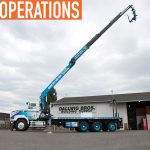I want to throw some statistics at you so we can start with a point of reference. On average, roughly 45,000 openings go unfilled every day for Class A truck drivers. The industry average age for truck drivers is 53. The biggest falloff in the driver industry is the age group of 25-40—a whopping 45% drop in the last five years. 40,000 CDLA licenses are issued every month in the US—by the end of one year, less than 5% of those drivers are still driving.
MOTIVATING FORCES
It is largely due to such statistics that Todd Warner founded the company Blue Bloodhound, an online marketplace allowing truck drivers to create a profile to market themselves as 1099 independent contractors. “I spent 17 years recruiting Class A drivers in the staffing industry,” explains Warner. “I was spending my world in between the two. One side being the truck driver, Class A, and looking for work—in most cases looking for extra work, extra hours of service (HOS), throughout the week. On the other side, I’m representing the motor carriers, 3PLs, and freight pro groups, who are all looking for a just-in-time solution, looking for a driver quickly.”
Having experience on both sides of the field put Warner in a prime position to offer a solution for both sides. “To be able to onboard a truck driver is such a long, cumbersome process of vetting and verifying their DOT file. It can take from seven to 10 days. So, companies are forced to try to go out there and find alternative resources to find quick solutions, because the transportation industry is very volatile. It’s on a 24/7 clock and you have to be able to react,” says Warner. “I kept trying to figure it out. There had to be a better way to do this, a better solution out there for both sides. We created Blue Bloodhound with that concept.”
SUPPLY AND DEMAND
Because of the driver shortage, drivers are in higher demand than ever. This opens the door for drivers to be more selective about the runs they take and the jobs for which they sign on. “What we’re trying to do with Blue Bloodhound is really reshape the workforce. And, the workforce right now is drivers,” explains Warner. “Whether over-the-road (OTR), regional, LTL, or local runs, if a driver doesn’t want to do a specific job anymore, they quit and get another. So, what we’re trying to do with our tool is leverage that need for a Class A driver in order to allow drivers to use their skillset to create more flexibility in their profession.”
Blue Bloodhound doesn’t limit this offering to one type of run. “It’s everything, absolutely every kind of run that a motor carrier would like to post—any type of endorsement, any type of vehicle. Carriers can post the runs in this open marketplace and any kind of driver can apply. As long as you have the qualifications that meet the motor carrier’s needs, apply,” says Warner.
RESHAPING THE WORKFORCE
In an effort to reshape the workforce, Blue Bloodhound’s mission is to bring an overall better experience to drivers, both incoming and veteran drivers. “I think there’s some cynicism out there regarding transparency of pay or the opportunity not being what a driver thought it was,” says Warner. For drivers coming in, the experience is often far from expectations, including participating in ride-alongs and completing runs outside of their wheelhouse, so to speak.
This disconnect between expectation and actual experience can be a driving force behind the driver decline. “I think there’s skepticism and cynicism out there from a driver standpoint and I think it’s our job to win drivers over and build trust,” says Warner. This cynicism and skepticism stems from poor experiences drivers have with carrier companies, an issue largely derived from restrictions companies face. Such restrictions are mostly logistic, including adhering to HOS regulations and keeping a certain number of drivers employed. The latter often can mean reduced driver hours and runs, leaving drivers not only unfulfilled, but underpaid.
By offering drivers a chance to market themselves as 1099 independent contactors, Blue Bloodhound can bypass a lot of the restrictions carrier companies face, offering flexibility to both drivers and carriers. “Once word gets out and drivers see how Blue Bloodhound works, that it really is an advocate for them, we think we’re going to win them over,” says Warner.
MARKETING INDEPENDENCE
So, how does Blue Bloodhound work and what exactly is it? “It’s match.com meets careerbuilder.com with a little bit of Uber thrown in at the end,” describes Warner. “Drivers complete a driver qualification file online, which is one of the unique features of the tool. It’s the only place I know of on the market today where a motor carrier can look for an employee—a contract worker in this case—and view their driver qualification file online and be able to make a hiring decision right then and there.
“Because the drivers are independent contractors and are not being hired by the motor carrier, they’re live. They can put the key in the ignition the next day. This online marketplace brings a driver for a specific run to motor carriers who are looking for just-in-time solutions. Carriers post the runs, put how much they’re going to pay, the description of the run—just like a job posting,” explains Warner. “So, the drivers have their profiles and can search for job openings, motor carriers search for drivers, and when they find each other and a match is made, the driver drives. Upon completion of the run, the driver sends an invoice via phone and is instantly paid by credit card.”
Blue Bloodhound opens the door for drivers to become their own boss. “Drivers have been so trained to think of themselves as employees, they’re hesitant and wonder if they will be forced to do a run they don’t want to. That’s one of the concepts we struggle with when expressing the idea to a driver,” says Warner. “But it’s the driver’s choice. They pick and choose what they want; they’re not made to do anything.”
And, for the driver, this service is free. “There’s never a charge for a driver. There’s no cost to them, they can come and go as they please, and they can use the app whenever they want,” says Warner. “Where we make money is on the motor carrier side. The motor carrier posts jobs like they would on a job board, but they only pay when a driver actually accepts that opportunity and drives for that motor carrier—and we charge a flat fee.”

The Blue Bloodhound app’s easy to use interface makes it convenient for drivers to create profiles and start searching for runs.
ACCESSIBILITY
With the number of interfaces to go along with today’s technology, Blue Bloodhound wanted to make sure that the app was accessible on a broad spectrum. Aside from just the standard PC/Mac internet browsers, drivers can use the app on Android and iOS systems. “Even though it’s a cumbersome application—it can be 25-45 pages with four uploaded documents—drivers can do all of it from their phone. They create their profile, make themselves marketable and, more importantly, make themselves a business,” says Warner. “We help them; we guide them through that process of creating themselves as a 1099 consultant that drives professionally. Then, we bring the business to them.”
“Sometimes there’s confusion when we talk in the industry about independent and 1099—everybody thinks, ‘Well that’s an owner/operator’ or ‘It’s a leased-on owner/operator.’ That isn’t the case,” continues Warner. “We actually went after the other 90% of the truck drivers out there—the 3.2 million that work as W-2 employees, but are in a constant need and constant search of fill-in HOS and work. Drivers can choose local runs, three-day regional, whatever it may be. The drivers can search and see what’s available, what motor carriers are paying, market themselves, apply, and pick up extra work as a 1099’er.”
RESULTS TO DATE
“We’ve been doing this for three months and in three months, we have more than 6,800 drivers registered into the tool and who have started using it,” says Warner of the company’s success so far. “We really did not expect that much of a response that quick. We went out to get drivers first. We felt we had to prove to the market and the motor carriers out there, the fleet owners, that we’re able to attract drivers.”
“It’s the number one question in the industry,” Warner continues. “Everyone needs drivers. Carriers don’t know where to find drivers, so we had to prove that point. Plus, drivers don’t expire—runs do. A motor carrier is going to post a job once or twice and say, ‘Hey, you have no drivers. I’m not doing this anymore.’ So, we really had to build up some mass and show that the concept was appealing to drivers—then we could go to motor carriers to post runs.
“Four weeks ago, we started our outbound campaign for marketing to motor carriers. At that time, we had 5,500 drivers coming in the system, registering. At that point, we needed jobs to convince drivers that this is really real,” explains Warner. “So, we’ve gone out to the motor carriers. We have about 300 motor carriers signed up right now.”
GOING THE DISTANCE
For as short a time as the company has been online, these are impressive starting numbers. There’s no sign of slowing down, either—only expanding. “We tried to start out regionally, because we knew we had to get mass to get traction. You have to have about 100 drivers lined up to be able to fill all the jobs that are going to come in from the motor carriers. We tried to keep it regional, but through the very nature of trucking, how it’s national, word spread. We’re now in every single state in the US, including Alaska and Hawaii,” says Warner.
Warner says that Blue Bloodhound uses Red Eye and Sirius Radio for marketing, as well as using basic job boards to attract drivers and get the word out nationally. “It seems like the drivers are willing to say, ‘Hey, I know you’re not in my town yet, but I’ll go ahead and fill out my file and wait until the jobs come.’ That’s sort of how it works. You’ll get a notification on your phone when a job posts in your area,” says Warner.

Carriers can choose from a pool of drivers in order to meet just-in-time run demands.
AIMING HIGH
Warner and the Blue Bloodhound team have already set specific goals for the future. “We’re hoping by the end of this year to have more than 50,000 drivers registered in the system. Currently, at the daily rate that we see right now, we think that’s very doable. That’s our goal on the driver’s side,” says Warner. “Our goal in two years is to be at 10,000 runs a day and we think we can meet that, as well. We hope to bring more drivers back to the industry. We think that’s how we can cut down the 45,000 openings a day.”
The Blue Bloodhound team is hoping not only to bring in new drivers, but to keep experienced drivers in the field. “We think we can activate or bring back—almost repurpose—the Class A workforce that’s out there. So, the goal is more efficiency out of the use of the driver to match more of the motor carrier’s needs. We kind of hope we redefine and redesign that workforce. We take these individuals and help them to plug-and-play in whatever opportunities they want. We allow the motor carriers to choose extra drivers when they need them.”
FOR MORE INFORMATION:
Find out more about Blue Bloodhound, visit www.bluebloodhound.com.
_______________________________________________________________________
MODERN WORKTRUCK SOLUTIONS: MAY 2016 ISSUE
Did you enjoy this article?
Subscribe to the FREE Digital Edition of Modern WorkTruck Solutions magazine.
![]()




